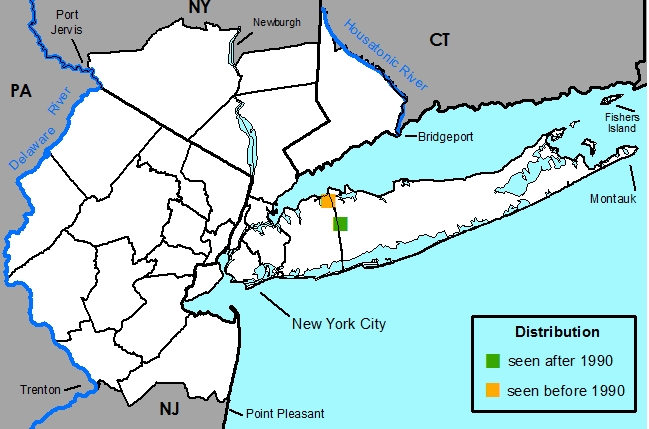Eubotrys recurva (Buckl.) Britton - Fetterbush

= Leucothoe recurva (Buck.) A. Gray
This species is native from the southeastern U.S., ranging as far north as Virginia. These records most likely represent accidental introductions with landscape plantings.
Common Names
FetterbushField Identification
Deciduous shrubs with elliptic leaves, recurved racemes of white vase-shaped flowers, and persistent capsules.Nomenclature
*Andromeda recurva Buckley, Amer. J. Sci. 45: 172. 1843. *Leucothoe recurva A. Gray, Manual, ed. 2, 252. 1856. *Eubotrys recurva Britton & A. Br., Ill. Fl. N. U.S., ed. 2, 2: 688, fig. 3239. 1913. TYPE: Type not designated, several elements. United States. Tennessee: Paint Rock, banks of the French Broad River, S. B. Buckley s.n. (Holotype: NY!) according to (Melvin, 1981).Description
HABIT perennial, deciduous, phanerophyte, shrubs, autotrophic, monoclinous, with fibrous roots, 1-4 m tall, not modified or with rhizomes (?).STEMS erect, round, not winged, "regular". Prickles absent. Bark fibrous, exfoliating, dark gray. Branches erect or ascending, gray or dark gray, round, not winged, 1.7-2.1 mm in diam. Twigs dark orange, not odoriferous, round, 1.2-1.5 mm in diam., smooth, hairs short and unbranched, spreading, multicellular, uniseriate, white, moderately dense, throughout, glabrescent, without glands. Pith present, light yellow, round, continuous, nodal diaphragm absent. Thorns absent. Aerial roots absent. Sap translucent. Resin absent.
BUDS terminal and axillary buds monomorphic. Terminal bud present, ovoid, 1.4-1.9 mm long, blunt. Axillary buds present, 1, ovoid, 0.8-1.9 mm long, blunt. Bud scales 10, dark yellowish orange, imbricate, ovoid, chartaceous, acute, hairs short and unbranched, spreading, multicellular, uniseriate, white, sparse, throughout, not glabrescent, without glands. Leaf scars crescent, 0.7-1.1 mm high, 1.1-1.3 mm wide, glabrous. Vascular bundle scars 1, crescent-shaped or circular, 0.2-0.3 mm tall.
LEAVES alternate, 1 per node, spaced ± evenly along stem, divergent from stem, simple. Stipules absent. Leaves petiolate, petiole "typical", 0.1-0.8 cm long, hairs short and unbranched or hairs long and unbranched, erect or spreading, unicellular, uniseriate or multiseriate, moderately dense or dense, throughout, not glabrescent, glands present or without glands, glands at apex of hairs. Leaf: abaxial surface light yellowish green, adaxial surface yellowish green, blades narrowly elliptic or elliptic, plane, symmetric, 4.3-11.5 cm long, 1.9-4.8 cm wide, coriaceous, base cuneate, margin serrate, apex acuminate or acute, abaxial surface hairs short and unbranched or hairs long and unbranched, appressed or spreading, unicellular or multicellular, uniseriate or multiseriate, white, sparse, throughout and along midveins, not glabrescent, glands present or without glands, glands at apex of hairs, dark orange-red, adaxial surface glabrous, without glands. Brochidodromous venation, veins 5-8. Leaf lobes absent. Spines absent. Tendrils absent.
INFLORESCENCES monomorphic, regular or, if dimorphic, female inflorescence simple, raceme, terminal or axillary. Peduncle absent. Rachis present, 3-9 cm long, with bracts. Bracts sessile, blades: abaxial surface light orange-yellow, adaxial surface light orange-yellow, lanceolate, plane, 5.2 mm long, 1.2 mm wide, base obtuse, margin serrate, apex acuminate, abaxial surface hairs short and unbranched, abaxial hairs spreading, multicellular, uniseriate, white, moderately dense, along midveins, not glabrescent, without glands, adaxial surface glabrous, without glands. Pedicel 2.1-2.5 mm long, glabrous, without glands. Bracteoles 2, sessile, at apex of pedicel, not connate, bracteoles: abaxial surface light orange-yellow, bracteole: adaxial surface light orange-yellow, ovate, curved, 2 mm long, 1.5 mm wide, base truncate, margin ciliate (with some gland tipped cilia), apex acute. Cupules absent.
FLOWERS precocious or coetaneous, formed on short shoots, monomorphic, with sepals and petals readily distinguishable from one another, bisexual, flowers white, 5-merous, (6-)7.5(-8) mm long, 4.1 mm wide, 8-27 flowers per inflorescence, fragrance present (?), perianth of two whorls. Calyx present, actinomorphic, acetabuliform, of free sepals, persistent, abaxial and adaxial surfaces the same color, light greenish yellow or light orange-yellow, 1.5-3 mm long, 3.5-5.2 mm wide. Sepals or sepal lobes 5, ovate, 2-3 mm long, 1-1.5 mm wide, base obtuse, margin ciliate, apex acute, abaxial surface glabrous, without glands, adaxial surface glabrous, without glands. Epicalyx absent. Corolla present, actinomorphic, urceolate, of fused petals, deciduous, abaxial and adaxial surfaces the same color, white, uniform, (6-)7.5(-8) mm long, 4.1 mm wide, corolla limb 1.5 mm long, 3 mm wide. Petals or petal lobes 5, "normal", trullate, 1.5 mm long, 1 mm wide, base truncate, margin entire, apex acute, abaxial surface glabrous, without glands, adaxial surface glabrous, without glands. Gynoecium syncarpous. Carpels 5. Stigmas 1, truncate. Styles persistent, 1, 2.1-6.5 mm long. Ovary superior, nectiferous disk present. Locules 5. Placentation axile. Androecium obdiplostemonous. Stamens 10, 4.5 mm long. Anthers cylindric, opening by pores, opening 1/4 of entire anther, bithecal, dark orange-yellow, glabrous, awned, with 4 awns per anther. Filaments free, straight, white, glabrous. Staminodes absent.
FRUITS loculicidal capsule, dark gray or black, subglobose, 3-5 mm long, 2.2-3.5 mm wide, glabrous, without glands.
SEEDS many, orange-yellow, wedge shaped, 1-1.3 mm long, 1 mm wide, wingless, not tailed, reticulate-foveate or reticulate.
Habitat
Mixed oak forest.Species Biology
FloweringMay [weeks 1 - 4].
Pollination
Unknown.
Fruiting
September [week 1]. Old fruit persisting until May [week 1].
Dispersal
Unknown.
Germination
Unknown.